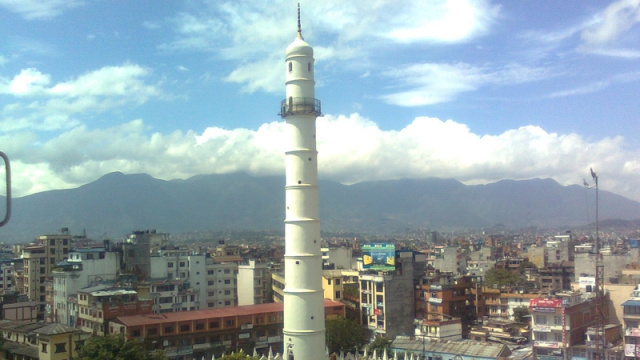An Ode to the Tower of Kathmandu

There was once a mythical ancient tower of Babel in Babylon. Its symbolic importance was that people were united by a single language and were inspired to create a tall tower that reached the heavens. According to one version of the story, confusion seeped in as multiple languages emerged—people were scattered—and the construction of the building halted. On this preface, what significance does cultural heritages hold in the present world? Can a landmark become a symbol for unity or divisions?
The first tower of Kathmandu was built in 1824, which was 11 stories high. The second tower was built in 1832 called ‘Dharahara’. It was built in Sundhara by then PM Bhimsen Thapa for his niece Queen Lalit Tripura Sundari. It was also known as ‘the pride of Kathmandu valley’ and was recognized by the UNESCO. Then the earthquake of 1834 jolted the towers to minimal damages. However, another earthquake on 15 January 1934 destroyed the first tower and the second tower was reduced to two stories from nine. The autocratic rule of Rana had already begun and it was the PM Juddha Shumsher who gave orders to restore it. The collapse of the first tower led to the naming of the second tower as ‘Bhimsen Stambha’ or ‘Bhimsen Tower’.
The simple reason for building Dharahara was for military purposes and to blow bugles during important events. This tradition ended when the first tower collapsed. It is not known if the guards died who were guarding it. But the 2015 earthquake killed 180 people who had climbed the rebuilt tower to have a view of the capital city.
Dharahara was opened to the public only in 2005 and although I was born and raised in Kathmandu, all these years I never had the urge to climb the narrow spiral staircases to have a panoramic view of the capital city. And in early 2016 former PM K.P. Oli announced that a new tower would be built again. Nepal Telecom, one of the largest telecommunication provider, has shown interest to invest when its services are erratic. In a nation where corruption is strongly linked with commissions ranging from 30 to 40 percentage, it is highly susceptible if the new tower will stand tall for long.
The new tower will be 11 stories with modern design and facilities such as parking and lift. It will also have a museum and a mini theater. Cage Consult Pvt. Ltd. claims that the tower will withstand an earthquake of 8 on Richter scale. However, the company is unsure about the materials that are going to be used for the construction.
Cultural heritages are “the legacy of physical artifacts and intangible attributes of a group or society that are inherited from past generations, maintained in the present and bestowed for the benefit of future generations”. The problem with cultural heritages is that people need to value, enjoy and take care of it. Also, it is imperative that the public understands what it means to them. The negative part is that cultural sites tend to implant a false whigmaleerie of superiority and divides people subsequently.
No public poll has been created to take a decision on the reconstruction of the tower. Even the public is divided as some vouch for it. Whereas, others like the poet and a former professor at Tribhuvan University, Prakash Subedi, believes that a fresh, healthy debate is needed about the reconstruction at a time when there are other issues that need immediate focus. He stresses that earthquake victims are still waiting for help from the government; the traffic lights in Kathmandu are dysfunctional, the roads in the capital city are not properly built; overhead bridges are built and brought down, and the list goes on. There are others who insist that cultural heritages shouldn’t be neglected as it is a part of the nation’s history, the present, and future. But at what cost?
Dharahara is another building that manifests the work of elites who try to control the thoughts of masses by making them believe that a tower will make their future better. Most people would gladly accept the move, hadn’t the government failed its people in the building of schools and health posts in rural areas. Couldn’t the government spend the money on those areas instead of building a tower in the middle of a city?
The raison d'etre for Dharahara in large embodied the power of the elites in the past and continues to become a landmark built by elites for their own purpose. Only the name and title of the elites have changed. Now they are politicians who try their best to accumulate power in the name of upholding nationalism and national pride. Perhaps they are right to a certain extent—that a heritage landmark can unite people. But recent developments have proved that Dharahara, perhaps, is meaningless to people. Would the families who lost their loved one’s last year have a soft corner for Dharahara?
The tower of Kathmandu has been razed to the ground twice. Once in the 1934 earthquake and another in 2015. There might be greed behind the zest to build it again believing it provides strength and hope to scores of Nepalese who continue to live a resilient life knowing another disaster is a step away. Yet sadly the tower holds little or no significance to the common Nepalese who don’t count their future based on the reconstruction of a tower that’s prone to collapse after several years. And who has continued to die because of it? The common people; elites stay away from the historical landmark and always capitalize on its vestiges for their own controlling purposes. There’s no end for the ruler’s me-tooism in failing to understand from the past’s disaster and taking pride on reckless construction activities.



